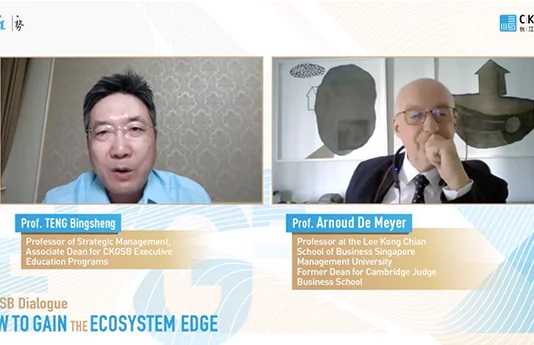The networked organization has changed how business innovates—but will the new system last?
Thanks to the internet, almost every aspect of business has changed dramatically over the past 20 years. From manufacturing and logistics to marketing and sales, little is done the way it used to be done.
But in the long run, the most important change may be the impact the global communications network has had on innovation. “I think it’s had a revolutionary effect on how innovation is done,” says Jaideep Prabhu, Director of the Centre for India & Global Business at Judge Business School, University of Cambridge. “It has taken innovation out of the big R&D laboratories, out of the hands of high priests in white coats, and made it accessible to people everywhere.”
Correlation is not causation, as scientists always warn, but by some measures, innovation does appear to be accelerating. Between 1995 and 2013, patent applications climbed from a little over 1 million to more than 2.5 million per year. The number of patents granted has climbed as well, from 400,000 in 1995 to 1.2 million in 2013, according to the 2014 World Intellectual Property Indicators, published by the World Intellectual Property Organization (WIPO).
But will it continue? On one hand, the internet keeps making it easier and easier for people to come up with new and better ideas. On the other, that same technology may have such a tendency toward winner-take-all markets that some scholars fear that as the top companies try to secure their advantage, they may end up setting limits on what currently looks like a limitless frontier.
How Innovation Became Easier
Purpose-built to meet the need of scientists to exchange data, the internet is now making it easier than ever for people to create innovations. Whether they communicate by email, video conference, three-dimensional rendering, or Microsoft Office files, marriages of true minds face fewer impediments than ever before.
In addition to being able to build teams irrespective of their distance, start-ups now have access to computing power, analytics and communication tools only the largest companies had access to 10 or 15 years ago, says Prabhu, coauthor of Frugal Innovation—How to Do More with Less.
One New York University economist sees the availability of on-tap computing and memory storage as a particularly important new advantage. Where 10 years ago, a start-up had to invest significant money in computer systems, today it will simply rent the computing power it needs, says Nicholas Economides, a professor of economics at NYU’s Stern School of Business and a noted scholar on network effects. “Now you can just go to Amazon or Microsoft or Google and rent computing power at a very low price, so innovating has become much cheaper.”
The most promising start-ups also don’t lack for friends. Scott Anthony, Managing Partner of Innosight, a Singapore-based innovation consultancy, has seen a growing symbiotic relationship between big companies and start-ups that continues to tighten.
“Large companies have unique assets but want a jolt of adrenaline. Small companies have the adrenaline but desperately need the assets,” Anthony says. “Out here in Asia companies such as DBS, MediaCorp and Globe Telecom have all created programs designed to physically house start-ups at or near their companies. I expect we’ll see more overlap of these ecosystems in the years to come.”
Big Firms Add Asian Research
Meanwhile, these big firms have taken advantage of technology to extend their research supply chains to emerging markets, particularly China and India, which can offer engineers at a fraction of the cost in the West, as well as direct knowledge of the needs of developing market customers.
In just two decades, these offshore research centers have become a major source of the world’s innovation. A majority of all patents granted in China and India are granted to inventors working locally for multinational companies or co-invented by international teams, according to a 2013 Carnegie Mellon study. At the moment, there’s still a division of labor between Asia and the West, with Asian labs handling more of the repetitive work, but the Carnegie scholars say this may change over time.
The numbers are also significant: the percentage of patent applications filed in high income countries as a share of the world’s total fell to 60.3% in 2013 from 85.7% in 2003, according to WIPO, as the share of applications from upper middle-income countries grew to 36.4% from 11.9% over the same period. Asian applications have climbed too, to 58.4% from 47.3%, largely at the expense of Europe’s share.
Anthony says that physical location matters less and yet is more important now than in the pre-internet days. “Location matters less because the work really can be done anywhere,” he notes. “But location matters more because increasing complexity of problems requires ecosystems, and ecosystems are more likely when human beings run into each other. One certainly observes that there are real clusters of innovation activities. Silicon Valley/San Francisco is obvious, but you also see things in places like Berlin, Jakarta, Singapore, Manila, etc.”
Even as this vertically integrated research system continues to mature, other internet-fueled technologies may lead to further changes in innovation. Prabhu believes that the rise of the Internet of Things will create an entirely new ecosystem of opportunities, as devices learn to talk to each other and apps are developed that can respond to the data being gathered, in order, for example, to tell farmers exactly where they should apply some extra fertilizer.
Another element that seems likely to be transformative is Big Data. As the old saying goes, what you can’t measure you can’t manage. As it gets easier and easier to collect data and sift it for patterns, the ability to optimize processes and understand customer needs is growing as well. A recent Boston Consulting Group study found that companies that are good at innovating are three times more likely to rely on Big Data analytics and data mining than companies that aren’t strong innovators (57% to 19%).
Perhaps most of all, the relentless growth of computing power is also likely to speed up innovation. IBM is already beginning to market its Watson supercomputer technology as a supportive network that can answer questions and learn. From inventing a new barbecue sauce to making medical diagnoses, the TV game show-winning supercomputer may be able to help companies more than currently forecast.
Why it Might Not Continue
On the other hand, certain factors raise questions about whether innovation can continue at its current pace and in quite its current form:
First, if this is a golden age of innovation, why are the numbers of tech start-ups declining? “There is very clear evidence that the rate of formation of new companies has declined, which is counter to this general mantra of easy start-ups and new technologies making it trivial for a high school kid in his bedroom to do something,” says Andrew Odlyzko, a professor of mathematics at the University of Minnesota, and a historian of industrial development, pointing to studies from the Kauffmann Foundation. A 2011 report, for instance, found that young tech firms declined as a share of total firms in the sector from 60% in 1982 to 38% in 2011.
Odlyzko argues that a number of factors may be driving this trend, including winner-take-all markets, artificial barriers such as regulations that discourage new entrants, and the sheer complexity of society.
Second, as innovation becomes easier, will it still be a source of competitive advantage? What’s already happened in chess may be a good preview of what will happen to companies as artificial intelligence (AI) becomes integrated into every domain. Gary Kasparov, the Russian grand master who lost to IBM’s Big Blue in 1997, has noted that after beating a Bulgarian grandmaster in a 4-0 match in 1998, he played him again the next month, but this time, each player had a computer assistant. The result: a 3-3 draw.
Third, will machines be as likely to take the kind of crazy chances—or even the mistakes—that lead to breakthrough ideas? Since Kasparov’s 1998 match, there’s been an arms’ race of chess programs that have yielded incremental improvements, but little true innovation, he noted in a 2010 New York Review of Books article. “Like so much else in our technology-rich and innovation-poor modern world, chess computing has fallen prey to incrementalism and the demands of the market,” he wrote.
(On the other hand, in certain circumstances, a supercomputer’s lack of preconceptions may make it easier for it to think out of the box. For instance, Watson’s white wine and butternut squash barbecue sauce is supposed to be good, although it is not a combination that any barbecue chef had ever considered before.)
Fourth, could today’s internet oligarchs slow down innovation, in order to hang on to their current advantages? After all, the logic that built the internet was the logic of the scientist, not necessarily the logic of the business owner. While the scientist looks at the internet and sees a platform for collaboration, the owner of an established network business may see either a risk, if they face disruptive competition online, or lost revenue, if the company is an internet service provider forced to offer the same service to high-bandwidth and low-bandwidth services.
Perhaps even more significantly, one Stanford Law School professor has argued that part of the reason for the tremendous gains of the past two decades has less to do with the nature of digital technology than the structure of the network. In her influential book Internet Architecture and Innovation, Barbara van Schewick argues that “dumb” networks like the internet tend by their nature to leave more room for innovation.
“Innovating on an integrated architecture provides an option on a portfolio, whereas innovating on a modular architecture provides a portfolio of options,” she writes. “…In a modular architecture, innovators can use any module innovation that is better than the existing module, and can reject the others. In an integrated architecture, an innovator has to accept or reject a complete system, improvements in some parts of which may be offset by deteriorations in others.”
In the US, the Federal Communications Commission recently said it would not allow internet service providers to charge sites for preferential service. However, industry appeals continue.
However, if that changes, reinventing the medium in a significant way may become much more difficult. You might invent Angry Birds; you won’t invent Skype.




















